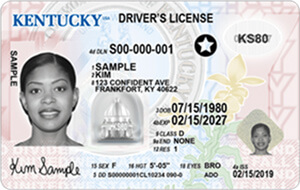
We've added this question
to your Challenge Bank™
All your missed questions are saved
automatically for extra practice.


Already in Your
Challenge Bank!™
It's a practice test that's automatically made up of all your missed questions. Once you finish this test, you’ll be able to revisit your Challenge Bank™ to practice and sharpen your skills.
View All PlansAdding questions to Challenge Bank™
is Premium members exclusive
Access 650+ exam-like questions, Pass Guarantee, personalized study plans, and more.
View All Plans- Updated for January 2025
- Based on official Kentucky Driver's manual
Free Kentucky DMV Practice Test Two 2025
Are you feeling that you’ve been bothering your friends with requests to give you a ride a bit too often? Well, if you had your own driver’s license, you wouldn’t have to do that. All you need to do is take the DMV test. Don’t get scared, it’s not at all as horrible as some people say. We’re here with our 2nd KY permit practice test to help you get ready for the real thing. Yes, our practice test doesn’t give you a driving license but it gets you one step closer to that. The test is based on the new 2025 Kentucky Driver’s Handbook and includes 40 multiple-choice questions very similar to those that you’ll see in the real DMV test.
To take our KY permit practice test, you won’t need to leave the comfort of your home, and guess what? You won’t have to pay or even to register. Start right now by reading the first question below and selecting the best answer option out of four. If you’re not sure, our hints will help you make the right choice. Look at the progress bar on the left-hand side of the page. It will show you which answers have been answered correctly, and our explanations will provide you with info that will help you improve your performance. We suggest that you also tell your friends about our KY permit practice test on Twitter or simply click the “like” button above. Good luck and see you a happy driver soon!
- Perfect for learner’s permit, driver’s license, and Senior Refresher Test
- Triple-checked for accuracy
What you need to know

What to expect on the actual KY KSP exam
questions
correct answers to pass
passing score
minimum age to apply
List of questions (classic view)
- If you are stopped for a traffic violation, which of the following documents must you provide to the police officer?
- You are in an intersection, waiting to turn left. The traffic light changes from green to yellow. What should you do?
- If a bicycle on your right reaches an uncontrolled intersection at the same time as you do, you must
- You approach an intersection with a steady yellow traffic light. You must
- You see a sign shaped like a pennant. What does this sign mean?
- What does this sign mean?
- The primary traveling aids for a blind person include
- Rear-end collisions are common on highways because many drivers
- When preparing to leave a parallel parking spot, you should
- If the vehicle behind you is tailgating you (following you too closely), you should
- You are on a two-lane road with traffic moving in both directions. To pass on the left, you must
- A "Speed Zone Ahead" sign means that you are approaching
- When you change lanes, all of the following are correct maneuvers EXCEPT
- Before reaching the crest of a hill or entering a curve, you must _________ and watch for oncoming vehicles.
- What does this sign mean?
- When entering a main road from a private road, a driveway, or an unpaved road, you must
- This sign is
- To guard against glare from the headlights of a vehicle behind you, use __________ and adjust it before you drive.
- Which of these statements about U-turns is FALSE?
- On an expressway, you can avoid highway hypnosis by
- At an intersection, a steady yellow left arrow means
- To turn from a one-way street onto a two-way or divided road, you should turn from
- Rain, snow, and ice impair your ability to see ahead and can make roads more slippery. To be able to stop safely, you should
- When making a left turn at a controlled intersection, you must yield to
- _________ are a pair of white or longitudinal lines that mark where pedestrians may walk.
- A double solid line next to your lane means that you are
- The standard method for turning around on a narrow, two-way street is called
- Which of the following are used as left-edge lines on divided highways?
- At an intersection at which the traffic lights are not working, you must __________ before entering the intersection and then yield the right-of-way.
- To pass a stopped emergency vehicle, you must
- This posted sign is
- If you are about to pass a bicycle to your right and an oncoming vehicle is approaching you on your left, what should you do?
- While driving in a roundabout, you are approached by an emergency vehicle using a siren, air horn, or flashing red or blue light. What should you do?
- If a car approaches you with its bright headlights on, you must __________ to prevent being temporarily blinded.
- Where there are two or more lanes of traffic in each direction, a broken white line is used
- A single broken yellow line usually marks the centerline of a two-way roadway where
- When there is water on the roadway, you must reduce your speed to prevent
- Work zone or construction zone signs have
- The distance your vehicle travels between the time you recognize a problem and the time you apply the brakes is known as
- You must keep your windshield wipers in good operating condition because
More resources
- Alabama: Test 1 / Test 2
- Alaska: Test 1 / Test 2
- Arizona: Test 1 / Test 2
- Arkansas: Test 1 / Test 2
- California: Test 1 / Test 2
- Colorado: Test 1 / Test 2
- Connecticut: Test 1 / Test 2
- Delaware: Test 1 / Test 2
- District of Columbia: Test 1 / Test 2
- Florida: Test 1 / Test 2
- Georgia: Test 1 / Test 2
- Hawaii: Test 1 / Test 2
- Idaho: Test 1 / Test 2
- Illinois: Test 1 / Test 2
- Indiana: Test 1 / Test 2
- Iowa: Test 1 / Test 2
- Kansas: Test 1 / Test 2
- Kentucky: Test 1 / Test 2
- Louisiana: Test 1 / Test 2
- Maine: Test 1 / Test 2
- Maryland: Test 1 / Test 2
- Massachusetts: Test 1 / Test 2
- Michigan: Test 1 / Test 2
- Minnesota: Test 1 / Test 2
- Mississippi: Test 1 / Test 2
- Missouri: Test 1 / Test 2
- Montana: Test 1 / Test 2
- Nebraska: Test 1 / Test 2
- Nevada: Test 1 / Test 2
- New Hampshire: Test 1 / Test 2
- New Jersey: Test 1 / Test 2
- New Mexico: Test 1 / Test 2
- New York: Test 1 / Test 2
- North Carolina: Test 1 / Test 2
- North Dakota: Test 1 / Test 2
- Ohio: Test 1 / Test 2
- Oklahoma: Test 1 / Test 2
- Oregon: Test 1 / Test 2
- Pennsylvania: Test 1 / Test 2
- Rhode Island: Test 1 / Test 2
- South Carolina: Test 1 / Test 2
- South Dakota: Test 1 / Test 2
- Tennessee: Test 1 / Test 2
- Texas: Test 1 / Test 2
- Utah: Test 1 / Test 2
- Vermont: Test 1 / Test 2
- Virginia: Test 1 / Test 2
- Washington: Test 1 / Test 2
- West Virginia: Test 1 / Test 2
- Wisconsin: Test 1 / Test 2
- Wyoming: Test 1 / Test 2
Your go-to, trusted source
Experience the Driving-Tests differenceOur commitment to accuracy and quality in our practice tests
Explore our rigorous, multi-tiered verification process that ensures each question mirrors the official manual for unparalleled accuracy.

At Driving-Tests.org, we understand the importance of reliable and accurate practice tests to help you prepare for your DMV exam. That's why we've developed a meticulous process to create and continually update our practice questions, ensuring they reflect the most current driving laws and regulations.
Here's an inside look at how we maintain the highest quality in our practice tests.
Content Creation and Verification Process
- Alignment with Official Manuals:
Every question we develop is based on the most recent version of each state's official driving manual. Our team regularly monitors each state DMV's website for the latest updates to ensure our practice tests are always aligned with the most current information. - Community Feedback Integration:
We leverage feedback from our vast community of users to understand which topics are most frequently tested. This helps us focus on the areas that are most relevant and beneficial for your preparation. - Expert Content Creation:
Our in-house editor, Steven, who has extensive experience in driver education, crafts each question with precision. He conducts a thorough review of each question against the official manuals to ensure accuracy. - Rigorous Review Process:
Once Steven has finalized a set of questions, our team conducts a joint review session. This second level of scrutiny involves content accuracy, proofreading, and fact-checking to eliminate any errors. - User Feedback Mechanism:
After a question goes live on our site, we keep the lines of communication open. Each question features a feedback button, inviting users to report any issues or errors. This continuous feedback loop allows us to address and rectify any concerns promptly. - Responsive Updates:
In line with our commitment to accuracy, we quickly update our practice questions to reflect any changes in the DMV manuals. Additionally, we update the free electronic copy of the state's driver's license manuals on our site, typically within a few days after the DMV publishes them.
Our thorough quality control process ensures that you have access to practice tests that are as accurate and up-to-date as possible. We believe in the power of well-prepared drivers and are dedicated to providing you with the best study tools to help you succeed on your DMV exam.
Unlock all 650 KY exam-like questions
Forget the stuffy classroom. Focus on what really helps you get behind the wheel, fast.
A self-paced program for people who have other obligations like school or work.
Kentucky questions seen on the real exam
Questions specific to your state. Breeze though your exam, or your money back.
Industry-leading 97% success rate
Compare with the average US passing rate of 49%.
Trusted by over 1.15 Million customers
The only program recommended by KSPs.






